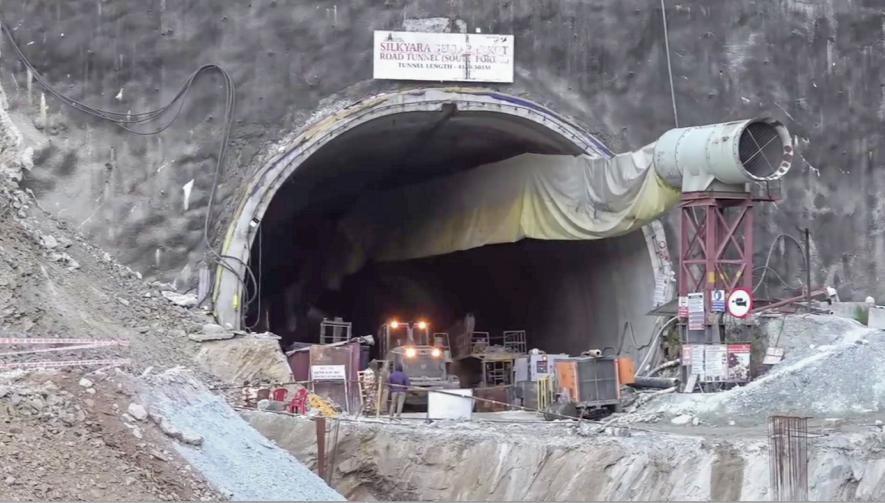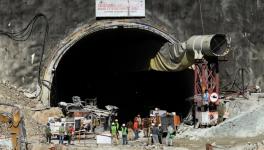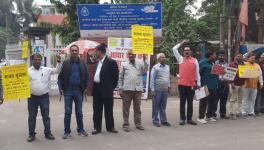Release of 41 Workers a Victory for Every Indian and a Cautionary Tale

File Photo. Image: PTI
As India celebrates the release of the 41 workers trapped in the Silkyara tunnel in Uttarkashi on 12 November, we must remember that the credit for the rescue goes to the jubilant workers. Indeed, the government extended the care and concern every worker deserves in such a situation. But can we afford to forget that workers rarely get such privilege?
The rescue in Uttarkashi is an opportunity for people and governments to comprehend the magnitude of the sacrifices of workers who labour under primitive conditions. The arduous rescue effort will hopefully inform the public about the risks of construction in mountainous regions, given constant seismic activity and inherent instability.
We also cannot ignore that the trapped workers were employed in the Prime Minister Narendra Modi government’s flagship Char Dham project. This 900-km road project, with a cost estimate of over Rs 15,000 crore, aims to connect the four Hindu shrines of Gangotri, Yamunotri, Badrinath and Kedarnath with a two-lane paved road.
It would be fair also to point out that the Char Dham project, as its name indicates, is crucial to the central government’s Hindutva project. Is that why no stone was left unturned to rescue these 41 workers? From foreign consultants to local experts, practically every arm of the government and private sector was roped in for the rescue operations. Unfortunately, this has not been the experience of many workers (and their families) who have been in similar unfortunate accidents.
One of the worst tunnel disasters took place when over 200 workers died in February 2021 when flood waters swept away the Rishi Ganga hydel project and the NTPC’s Tapovan-Vishnugad project. But several families of the affected have reportedly still to be issued death certificates and are still awaiting the Rs 20 lakh compensation per worker announced by the government soon after the disaster.
Alok Verma, a retired chief engineer of the Indian Railways, points out that over 12 tunnel collapses have occurred in the Himalayan region in the recent past. The Indian Railways have been involved in building many of these tunnels, but while the collapses have been examined in internal government reports, they were almost unnoticed by the media.
Another 23 workers died when a railway bridge collapsed in the Aizwal district in Mizoram last year. In another accident, 61 people were killed when a massive landslide hit a mega railway project in Manipur’s Noney district, including three railway engineers in 2022. But none of these witnessed the kind of mobilisation of resources put into the Uttarkashi rescue operations. Nor did the media pay half the attention to the victims, survivors, or their next of kin as in Silkyara.
Of course, what set the trapped workers in Silkyara apart was the miraculous situation—they were all alive and well, unlike other disasters in fragile zones, where survival is a big question after such a collapse. Nevertheless, the tremendous effort to provide provide the 41 workers with medical aid and rations right through their ordeal is very worth mention. During the last four days, they were fortunate to even receive hot khichdi in plastic bottles, dry fruits, and other essential items—even some games to help pass the time!
As the 41 workers were wheeled out of the cave two days ago, the first celebratory moments belonged to them entirely. At 8.30 pm on Tuesday, 51-year-old Gabbar Singh Negi was the last to be wheeled out, shaken but unhurt. He burst into tears when he saw the stars sparkling in the dark mountain sky.
Negi, a foreman for the construction team hired by the Navayuga Engineering Company in charge of the tunnel construction, is from Uttarakhand and was the eldest among the trapped workers. Throughout the ordeal, he kept up the morale of the other workers. The fact that the outside world was in touch with them using walkie-talkies also helped keep hope alive.
Once they were brought outside, waiting ambulances whisked them away to a nearby health facility. On Wednesday morning, they were flown by helicopters to the Jolly Grant airport and taken for check-ups at an AIIMS facility in Rishikesh.
Efforts to clear the 60-metre blockage in the Silkyara tunnel and create an exit passage for the trapped workers faced several obstacles. Two augur machines, one flown to the site in a hastily prepared landing space for the large IAF Hercules aircraft and the other brought by road from Hyderabad, broke down while drilling.
Several alternate rescue plans were devised. The ONGC and the Satluj Jal Vidyut Nigam, under the supervision of the Bengal Sappers of the Indian Army, were asked to start drilling vertically while workers hired by the National Highways Infrastructure Development Corporation supervised by the Border Roads Organisation and other agencies continued drilling horizontally.
After facing repeated obstructions and delays, the government brought twelve “rat miners” who dug the final twelve metres. Munna Qureshi, one of the most experienced miners, worked non-stop for 24 hours to clear the debris. His colleague, Feroz, helped dig through the last two metres. They were the first to meet the trapped workers as they were wheeled out.
This moment of tremendous comradeship again was a blow against the divisive tunes Hindutva has been playing, ironically, even in the hilly state of Uttarakhand. “The workers stopped and hugged them and thanked us profusely for our assistance,” Qureshi told the media at the tunnel site.
Other developments at Silkyara sharply contrasted the attitude of state and central governments when major calamities afflicted the country. During the second COVID-19 lockdown, lakhs of migrants were forced to trudge back to their homes, often hundreds of kilometres away. Governments watched vast waves of old and young people carrying their meagre belongings, walking in the hot sun, with little help, if any. Many perished on their arduous journeys, receiving neither food nor water from those in power.
The same indifference manifested on 8 November 2016 when Prime Minister Narendra Modi, with only a four-hour notice, made virtually all the cash in the seventh-largest economy worthless. Modi described it as an attempt to curb black money. But for the next few weeks, it forced lakhs of people to stand in long queues clutching notes to exchange them for lower-denomination currency. It was a heartless act which neither curbed black money nor stopped, as claimed, terror financing.
Many questions remain unanswered about the partial collapse of the Silkyara tunnel, the most crucial being the alleged absence of safety exit routes that could have helped workers escape during any disaster. Hopefully, these questions will have answers at a more opportune moment. For now, we must celebrate the culture of respect displayed in this tremendous rescue effort—such a culture is a must to ensure social justice and equality, especially in a nation with a shortage of both.
The author is an independent journalist. The views are personal.
Get the latest reports & analysis with people's perspective on Protests, movements & deep analytical videos, discussions of the current affairs in your Telegram app. Subscribe to NewsClick's Telegram channel & get Real-Time updates on stories, as they get published on our website.























